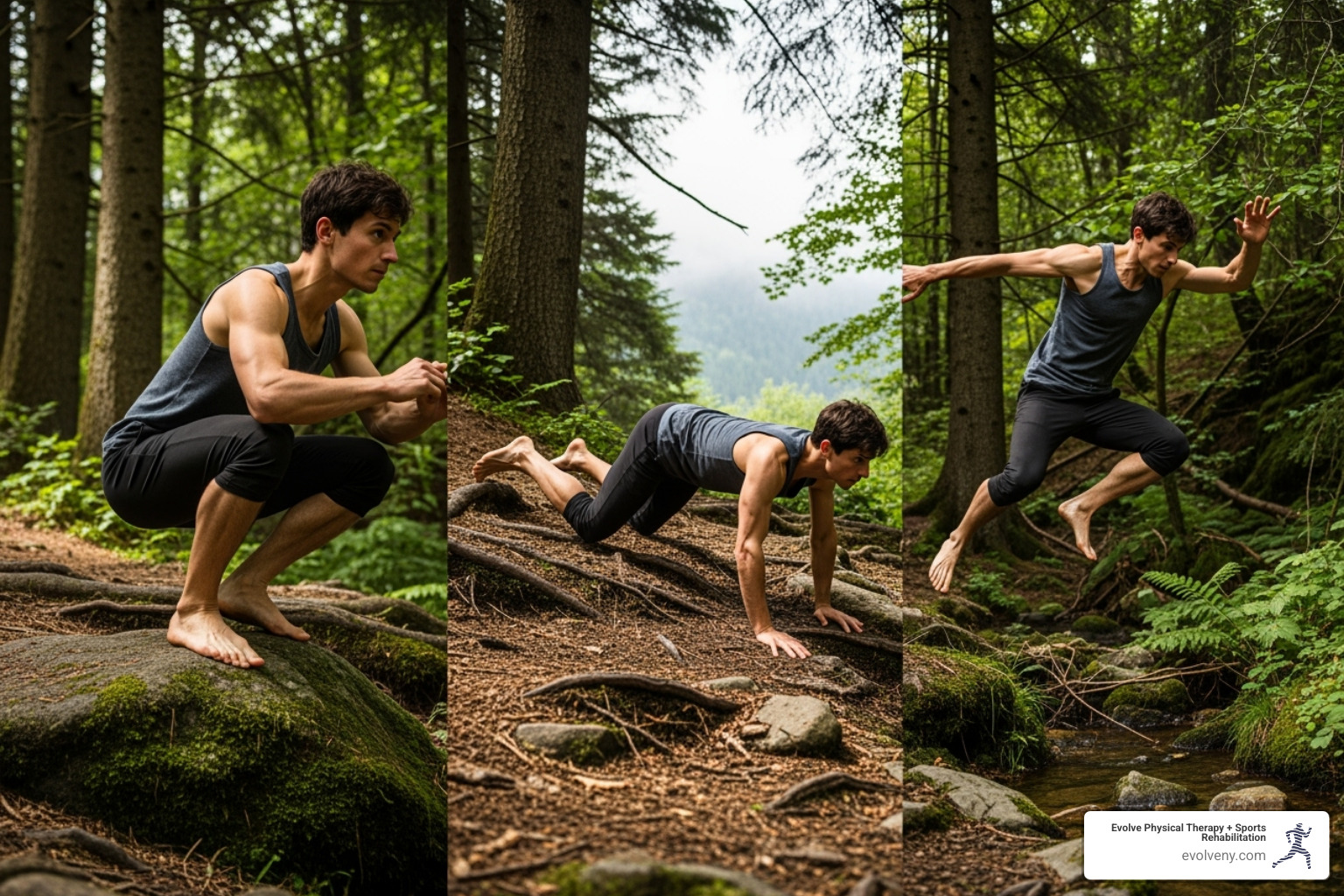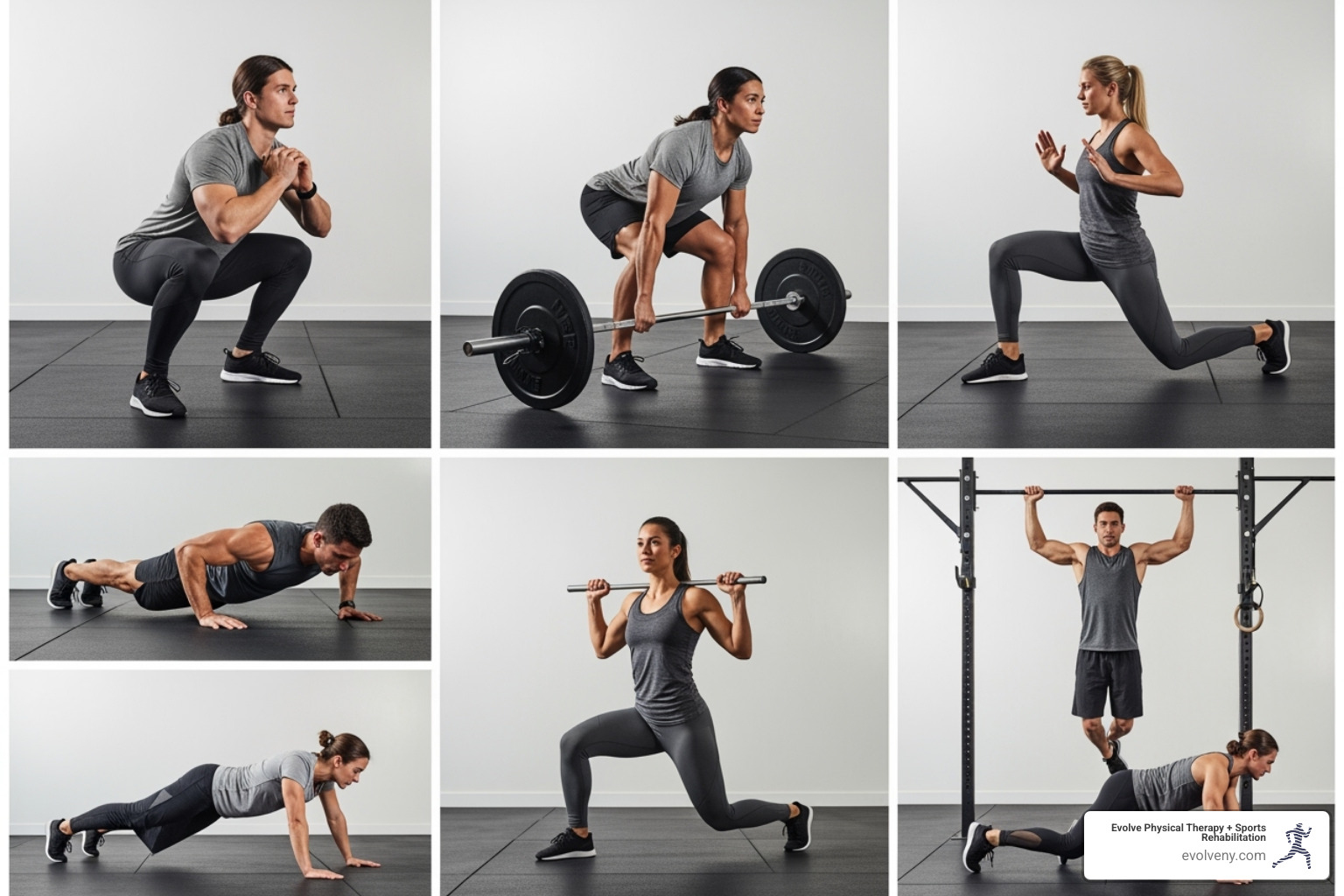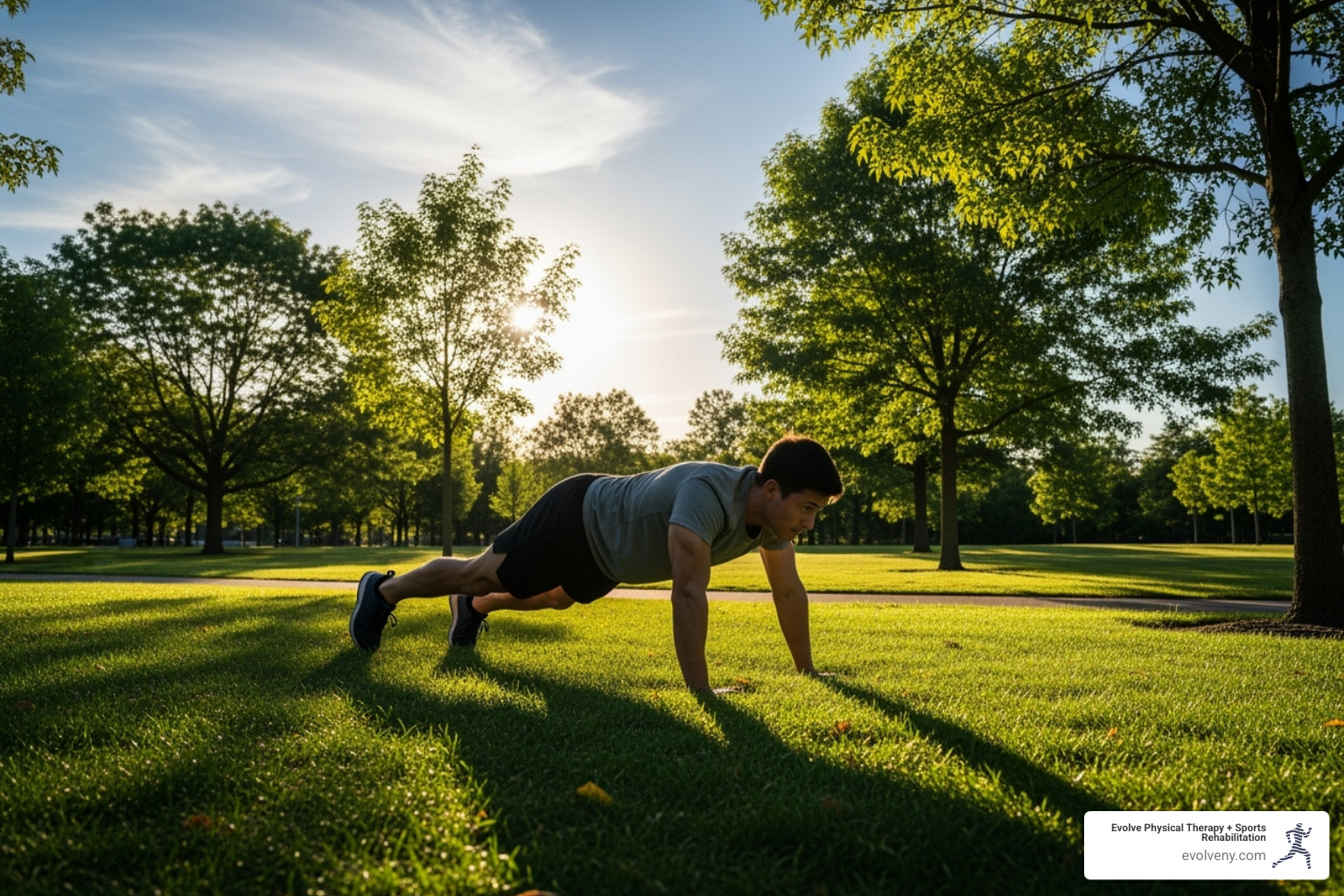Primal Movement Mobility – Unleash Your Inner Animal
Refind How Your Body Was Designed to Move

Primal movement mobility is a return to the fundamental patterns that defined human survival: squatting, crawling, jumping, pushing, pulling, and carrying. These movements are the foundation of how our bodies are designed to function.
What is primal movement mobility?
- Mimics our ancestors' daily activities
- Works multiple muscle groups simultaneously
- Prepares your body for real-world activities
- Restores your full range of motion
- Emphasizes body awareness over repetitive isolation
Modern sedentary lifestyles have disconnected us from these instinctive capabilities. As one movement expert puts it: "Modern science is finally catching up to what our ancestors knew intuitively: movement is medicine."
Unlike traditional gym workouts that isolate muscles, primal movement trains your body as an integrated system. This approach restores the natural mobility and coordination that keep you pain-free and moving efficiently.
The benefits extend beyond the gym. Research shows grip strength predicts overall mortality, and balance issues are a leading cause of injury-related death in people over 65. Primal movement addresses both by developing functional strength and neuromuscular control.
I'm Lou Ezrick, a physical therapist with nearly two decades of experience. At Evolve Physical Therapy, I've seen how primal movement mobility transforms lives by reconnecting people with their body's innate capabilities.

What is Primal Movement and Why Does it Matter?
Our ancestors' survival depended on natural movement patterns like crawling, climbing, squatting, and carrying. This is the essence of primal movement mobility: reconnecting with how our bodies were designed to move.
The key difference from traditional exercise is its integrated approach. Most gym routines isolate single muscles, but primal movements are compound movements that engage the entire body. A deep squat, for example, works your legs, core, back, and ankles simultaneously. This builds functional strength for real-life tasks like lifting a child or moving furniture.
As physical therapists, we see daily how sedentary life leads to lost mobility and chronic pain. Primal movement mobility aims to restore these lost capabilities, reclaiming the efficiency and resilience of our ancestors. How physical therapy approaches movement explores this connection between natural patterns and healing.
The Mind-Body Connection
Primal movement is more than just physical. When we're always "in our heads," it offers an antidote with its philosophy of "think less, move more."
When you crawl, balance, or twist, your mind must focus on the present moment. This improved body awareness (proprioception) becomes a form of active meditation, forcing you out of mental chatter and into mindfulness in motion. The result is reduced distraction, better coordination, and a deeper connection with your physical self.
The Rise of a Fitness Trend
Primal movement mobility has recently grown in popularity as people seek a holistic fitness approach that improves daily function. Its beauty lies in its accessibility for all levels.
You don't need expensive equipment; your body is the primary tool. This minimal equipment appeal makes it perfect for home workouts or quick movement breaks. The trend reflects a broader shift toward functional fitness—movement that serves your life outside the gym.
The 7 Foundational Primal Movement Patterns
At the heart of primal movement mobility are seven foundational patterns. Mastering these movements is key to open uping your full physical potential.
Here are the seven patterns:
- Squat: Descending the hips below the knees.
- Hinge: Bending at the hips with a relatively straight back.
- Lunge: Stepping forward, backward, or sideways, dropping one knee towards the ground.
- Push: Moving an object or your body away from you.
- Pull: Moving an object or your body towards you.
- Twist (Rotation): Rotating your torso.
- Gait (Locomotion): Moving from one place to another (walking, crawling, running).

1. The Squat
The squat is a fundamental human movement, though this natural ability often diminishes with age. A deep squat requires hip and ankle mobility, plus lower body strength. It improves core stability, coordination, and is associated with a lower risk of falls.
Example: A bodyweight squat. For a modification, squat to a chair or bench.
2. The Hinge
The hinge pattern is essential for safe lifting and protecting your lower back. It involves bending at the hips with a neutral spine, engaging your glutes and hamstrings. Mastering the hinge teaches proper lifting mechanics for everyday tasks.
Example: The Glute bridge is a great starting point. Progress to a Romanian Deadlift (RDL) with a light weight to practice the full motion.
3. The Lunge
This single-leg movement challenges your balance, coordination, and strength. It's critical for walking and running. Lunges improve neuromuscular control and can address muscular imbalances, leading to more efficient movement.
Example: The walking lunge. Step forward, lowering your hips until both knees are bent at roughly a 90-degree angle, then push off into the next lunge.
4. The Push
Pushing movements are vital for upper body strength in tasks like pushing open a door or getting up from the ground. They engage the chest, shoulders, and triceps, while the core provides stability. Pushing exercises also improve bone density and shoulder health.
Example: The classic push-up, which can be modified from wall push-ups to full variations.
5. The Pull
Often overlooked, pulling movements are crucial for posture and spinal alignment by working your back muscles, biceps, and forearms. They are also excellent for developing grip strength, a proven predictor of overall mortality.
Example: A bodyweight row or a simple bar hang. Hanging from a pull-up bar is great for grip strength and spinal decompression.
6. The Twist (Rotation)
Rotational movements are essential for spinal mobility and core power. Neglecting this pattern can lead to stiffness and injury risk during daily activities like reaching or throwing. Twisting engages your obliques and keeps your spine healthy.
Example: The standing torso twist. Stand with feet shoulder-width apart and gently rotate your torso from side to side.
7. The Gait (Locomotion)
Gait includes all forms of moving from one place to another, such as walking, running, and crawling. This fundamental pattern improves cardiovascular health, cognitive performance, and emotional well-being, keeping the entire body integrated. To dive deeper into improving your balance and gait, we have a comprehensive guide available here.
Open uping the Longevity Benefits of Primal Movement Mobility

Primal movement mobility is key to functional aging—aging on your own terms. By practicing these movements, you build the strength, mobility, and coordination that will serve you for decades. Think of it as an investment in your future self, ensuring you can get up from a chair or play with grandchildren with ease.
At Evolve Physical Therapy, we see patients find new levels of vitality by embracing natural movement. This holistic approach is central to our philosophy of physical therapy and overall wellness.
Build Resilient Strength and Prevent Injury
Falls are the leading cause of injury-related death in people over 65, but most are preventable. Primal movement mobility builds resilient strength—the kind that protects you in real-world situations. It's your body's ability to coordinate, balance, and react instinctively.
- Joint stability: Movements like crawling and rotating teach your shoulders, hips, and spine to be stable through complex patterns.
- Core control: Your core learns to function as it should—bracing, stabilizing, and supporting your spine during real activities.
- Grip strength: Primal movements like hanging and carrying naturally develop grip strength, a surprising and powerful predictor of longevity.
Improve Mobility and Bone Health
Stiffness is often the result of not moving through a full range of motion. Primal movements combat this by taking your joints through their natural ranges in a functional way, creating lasting mobility.
- Joint health: Movement lubricates your joints with synovial fluid, keeping cartilage healthy and reducing inflammation.
- Bone health: Research shows that resistance exercise significantly improves bone density. Primal movements provide this load naturally.
- Hormonal homeostasis: The varied nature of these movements helps regulate your endocrine system, leading to better sleep, mood, and metabolism.
These movements restore confidence in your body, creating a positive cycle of activity and vitality.
How to Integrate Primal Movements into Your Routine
You can easily integrate primal movement mobility into your day without special equipment. The secret is to start small and stay consistent, as your body responds best to regular, gentle challenges.

Starting Your Primal Movement Journey
Find natural entry points in your existing routine:
- Morning warm-ups: Spend 5-10 minutes waking up your body with squats, hip hinges, and arm circles.
- Microworkouts: Use two-minute breaks to do a deep squat while coffee brews or a bear crawl during a TV commercial.
- Dedicated primal sessions: Set aside 20-30 minutes weekly to play with different movement patterns without pressure.
- Combining with bodyweight training: Alternate between movements like push-ups, crawls, squats, and lunges for a more engaging workout.
Adapting for All Fitness Levels
Primal movements scale to your needs. Beginners can modify exercises: squat to a chair or do push-ups against a wall. The goal is progress, not perfection. Your bodyweight is the perfect starting weight.
As you get stronger, advanced progressions emerge. You can add a weighted vest, try pistol squats, or explore complex flows. Adding external load or increasing complexity keeps your mind and body challenged. Unilateral variations (single-side movements) are great for addressing imbalances.
Risks and Considerations for Primal Movement Mobility
While safe, smart preparation is key.
- Proper form matters more than intensity. Slow down and focus on quality movement.
- Listen to your body. Mild soreness is normal, but sharp pain is a signal to stop.
- If you have chronic pain or previous injuries, consult a professional. A physical therapist can create a customized plan that works for your body.
At Evolve Physical Therapy, we specialize in creating safe, effective programs. Learn more about our therapeutic exercise programs here – because movement should heal, not harm.
Frequently Asked Questions about Primal Movement Mobility
Here are answers to common questions about primal movement mobility.
Do I need special equipment for primal movements?
No, your body is the only equipment you truly need. The vast majority of primal movements are bodyweight exercises like squats, lunges, and crawls.
As you progress, simple tools can improve your practice. A pull-up bar is great for grip strength, while kettlebells or sandbags can add load to squats and hinges. Resistance bands can also provide assistance or help activate muscles. Don't let a lack of equipment be a barrier; start with your body.
How is this different from calisthenics?
There is overlap, as both use bodyweight exercises. However, calisthenics often focuses on mastering specific skills like handstands or muscle-ups.
Primal movement mobility takes a broader approach, focusing on the natural, integrated patterns our ancestors used. This includes more locomotion (crawling, rolling) and ground-based movements. While calisthenics is about achieving impressive feats, primal movement is about moving gracefully and powerfully through your environment. You can learn more about how calisthenics fits into the mobility picture in our detailed guide here.
Can primal movement help with my chronic back pain?
For many, yes. Much chronic back pain stems from a weak core, poor movement patterns, and lack of hip and spine mobility. Primal movements directly address these issues. The hinge pattern teaches safe lifting, while squats and crawls strengthen the core and glutes that support your spine.
However, chronic back pain needs a proper diagnosis first. While primal movement can be therapeutic, we always recommend consulting a physical therapist to understand the root cause of your pain. At Evolve Physical Therapy, we create customized programs to address the underlying dysfunction and build a more resilient body.
Reclaim Your Body's Potential
The freedom of movement you had as a child isn't gone—it's waiting to be refinded through primal movement mobility. By strengthening your body with natural squats, improving posture with pulls, and building resilience through functional patterns, you reconnect with your body's original blueprint.
The benefits impact every aspect of life:
- Better mobility to play on the floor with grandchildren.
- Improved strength to carry groceries without risk.
- Improved balance to move through your day with confidence.
Most importantly, primal movement fosters a genuine mind-body connection. It's about honoring the body you live in and giving it the movement it craves.
At Evolve Physical Therapy + Sports Rehabilitation, we help individuals refind their body's potential. Our experts guide you through a safe, progressive movement practice custom to your unique journey. Whether you're dealing with chronic pain, recovering from an injury, or just want to move better, we can help.

